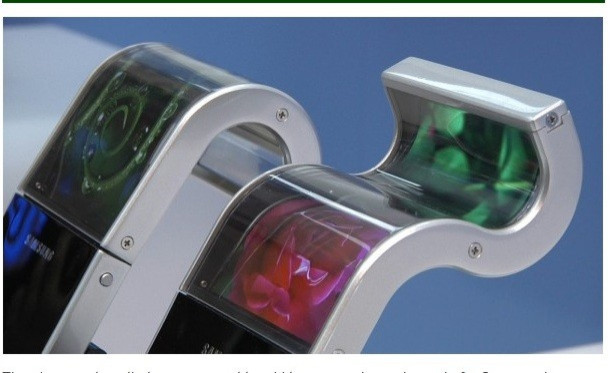Samsung AMOLED Display: 'Virtually Unbreakable' Flexible Screen In The Works [VIDEOS]

Samsung may be creating some buzz with its coming Galaxy S3 smartphone, but the Korea-based company has something more groundbreaking in the works. Screens featuring flexible display technology are expected to be launched on the manufacturer's products in the near future, according to Android Authority.
Not only does this new technology allow screens to bend any which way, but the display is thinner, lighter and virtually unbreakable. This AMOLED screen is made of four layers, and will be referred to as YOUM. Samsung has not clarified whether or not this is an acronym, but the technology has been referred to in all capital letters.
YOUM takes the standard OLED design and replaces the glass substrate and encapsulation layers with flexible polymer sheets. This makes the screens more durable and lighter than current models. The screen is composed of an organic layer sandwiched between two film layers with a polarizer overlay.
While some sources such as The Christian Post's Tech and Biz section and Mashable say the technology could debut sometime this year, Droid Life reports that devices could start shipping in 2013.
There is much to look forward to, the Android-based news site wrote. Could you imagine being able to drop your device with no worries of cracking and shattering your display? Sounds like paradise.
Samsung released videos showing off the flexible technology as early as December, and recent patents show that development is well under way. The company has filed trademarks for names such as FAMOLED, WAMOLED, PAMOLED and TAMOLED.
Android Authority also predicts that early forms of the new display will be more subtle that what Samsung has boasted in its videos.
You know, something along the lines of a device with a curved display, instead of a wearable Android wristband, the website wrote.
But the real question that fans and techies may be wondering is, how can this technology be put to use?
It seems like the manufacturers involved may still be struggling to figure out a way to integrate these kind of systems with smartphones that feels actually useful, and not just like a gimmick, wrote Mashable.
Although this technology has been showcased on a smartphone-based scale, bendable screens may also make their way to tablet devices such as iPads. A report from Android Authority in early March says that Apple is rumored to be talking with Samsung about implementing flexible AMOLED displays for future models.
But for now, nothing is certain, because Apple demands improved resolutions and bigger production capactities, wrote the Android news site.
To get a preview of what Samsung has been working on, check out the videos below.
© Copyright IBTimes 2025. All rights reserved.






















